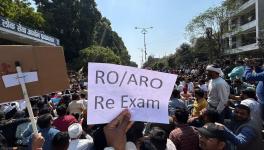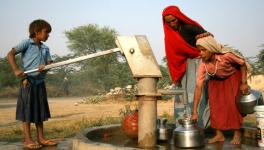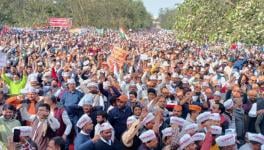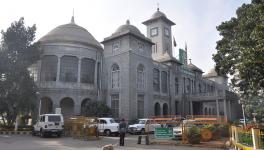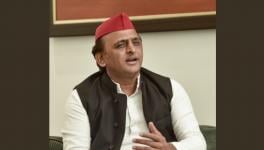UP Urban Bodies’ Elections: BJP Faltering in Small Towns
Image Courtesy: PTI
The latest urban local body elections in Uttar Pradesh (UP) were held on May 4 and 11, 2023, and the results were declared on May 13. Although the event was overshadowed by the Karnataka Assembly election results announced on the same day, mainstream media and UP political circles were effusive in their praise of the ruling Bharatiya Janata Party (BJP) for having won all 17 mayor’s posts. However, analysis of the detailed result – now available at the State Election Commission website – shows a different picture. The BJP appears to dominate the mayoral elections but as you move down the hierarchy, it clearly slips yielding more and more to other parties and, most notably, to independents.
About 20% of the population of UP lives in urban areas – and about 1.92 crore voters were eligible to vote in this round of elections of which, about 53% actually voted. The urban areas are governed by a three-tier structure of urban local bodies. There are, in all, 740 urban local bodies made up of 17 municipal corporations, 199 nagar palika parishads and 544 nagar panchayats. The corporations are headed by a directly elected mayor, while each of the other two types of bodies are headed by directly elected chairpersons. Elections are held every five years.
The results show that the much-celebrated dominance of BJP in urban areas of the state is built on rather shaky foundations. It is able to win larger direct elections (like mayors and chairpersons) but at the ward levels, this advantage erodes rapidly. Let us look at the detailed results.
Municipal Corporations
Although it won all 17 of the mayoral contests, the BJP’s performance was markedly less impressive among the 1,420 wards that make up these 17 corporations, which include main cities, such as Lucknow, Kanpur, Prayagraj/Allahabad, Varanasi, Gorakhpur, Saharanpur, Ghaziabad, Meerut, etc. As the chart below shows, BJP won 57% of the 1,420 corporators elected while 28% were won by Opposition parties, such as Samajwadi Party, Bahujan Samaj Party, Congress, etc. Independents won 15% of the corporators seats.
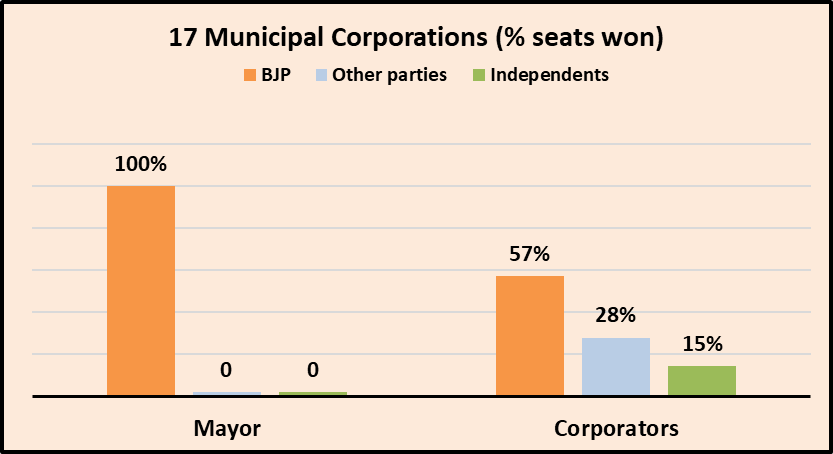
In absolute numbers: of the 1,420 total seats of corporators, BJP won 813, Opposition parties won 401 and independents won 206. Holding the mayor’s post gives dominant executive power but the ward-wise results show that political influence is not so dominant at the ground level.
Nagar Palika Parishads: BJP Won Only 26% Members
In this second tier of the urban local body hierarchy, the hint of faltering support at the ground level seen in municipal corporations becomes even more pronounced. As shown in chart below, the BJP won 45% of the chairpersons but it could win only 26% of the 5,327 councillors. Opposition parties won 35% of chairpersons’ posts but only 16% of the councillors. Independents, however, won 59% of the councillors though winning only 21% of chairpersons posts.
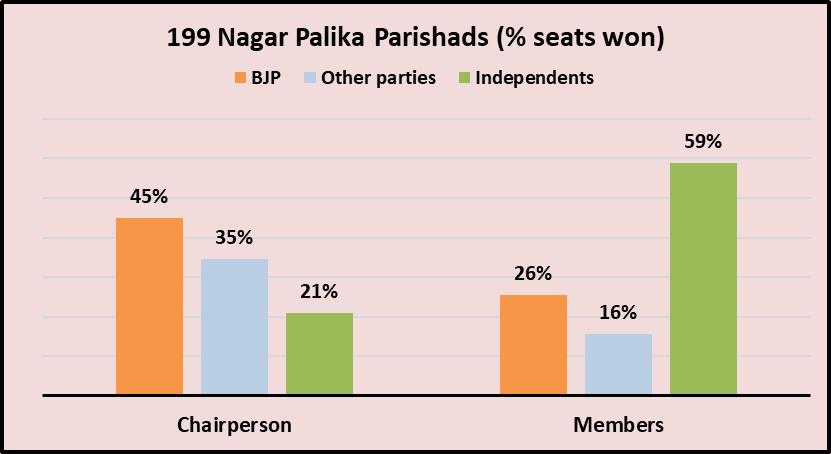
Out of the 5,327 members in all (spread over 199 NP Parishads), BJP won 1,360, Opposition parties won 837 and independents won 3,130 seats.
What these results for the middle-level urban cities/towns show is that there is rejection of most political parties to lesser or greater degrees. Independents, who have a better connect with the common people and are more accessible, are being preferred. This gets further confirmed when we look at the results of the lowest tier, the Nagar Panchayats.
Nagar Panchayats: BJP Won Only 20% Members
There are 544 Nagar Panchayats in UP, each with a directly elected chairperson besides having 7,177 elected members in all. Election results indicate that BJP won 35% of chairpersons posts while Opposition parties put together managed to get 29% of these posts. But Independents won the remaining 36% chairpersons posts. Among nagar panchayat members, BJP could win only 20% seats while Opposition parties won 13% but Independents cornered a whopping 67% of seats. (See chart below)
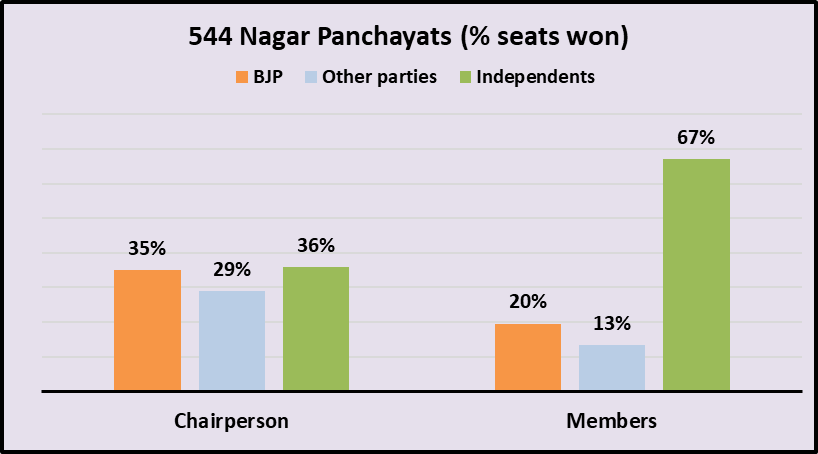
There were 7,177 members to be elected from 544 Nagar Panchayats, out of which, BJP won only 1,403, Opposition parties won 949 and Independents captured 4,825.
Clearly, at the Nagar Panchayat level, BJP’s dominance is significantly fraying. The wards from where these Nagar Panchayat members are elected have a few thousand voters living in small localities. Voters are not happy with the BJP candidates. This could be either due to those candidates not being very effective or accessible, or it could be a more generalised disaffection with the party itself. Either way, it should send alarm bells ringing among BJP top brass.
Who Are These Independents?
Some believe that most of these Independent winners are inclined towards BJP and should be practically counted as BJP. While it is possible that a section of them are BJP supporters who did not get tickets from the party and contested as Independents but it needs to be noted that people voted for them in a contest against BJP official candidates. So, the political mandate was anti-BJP. Of course, the mandate was also against many other political outfits in the fray. This must be a cause for worry for the BJP higher ups because large sections of urban population voting against their official candidates is surely a sign of discontent with the ruling party, that too, a ‘double engine’ government, as repeatedly described by all, PM Modi downwards.
As far as future activities and alignments of these Independents are concerned, it will not be surprising if many or even most of them turn to supporting BJP in day-to-day functioning of the respective local bodies at each level. Funds and patronage play a large part in the functioning of these bodies and blandishments of a thousand types may be available. However, if governance is not good and promises are not delivered then this would be a short-sighted approach and the present victors may not last beyond this term.
Why Discontent With BJP?
Be that as it may, the defeat of BJP official candidates at this sweeping scale indicates a larger pan-state malaise. This has two components: local and larger. At the local level, the failure of successive governments to transfer powers to urban local bodies, as envisaged in the 74th Constitution Amendment of 1994, and to sustain them in the present mendicant status, is the root cause of disaffection with the functioning of these local bodies. This trend appears to have at least continued – if not worsened – under the BJP rule since it came to power in Lucknow in 2017. Reports from Comptroller and Auditor General (CAG) of India indicate diverse failures to transfer mandated functions and resources to local bodies.
Added to this dismal situation is the multiple failures of the “double engines” – the Yogi and Modi governments. These range from price rise and unemployment to discontent among the farming community, lack of basic urban facilities and even issues like social strife or law and order. Although these are not under the purview of local bodies, they do feed into the making up of minds of urban voters.
With Lok Sabha elections slated for next year, the disaffection among UP’s urban voters must be causing some worries to the BJP. It also indicates that the Opposition needs to get its act together if it aspires to mount a viable challenge to BJP.
Get the latest reports & analysis with people's perspective on Protests, movements & deep analytical videos, discussions of the current affairs in your Telegram app. Subscribe to NewsClick's Telegram channel & get Real-Time updates on stories, as they get published on our website.









